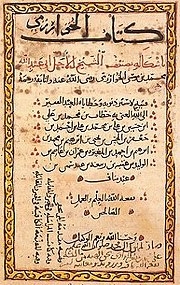
The English word ‘algebra’ is derived from the Arabic word al-jabr, meaning ‘reunion of broken parts’, describing the method for balancing both sides of an equation.
Persian mathematician and astronomer, Abu Ja’far Muhammad ibn Musa al-Khwarizmi, is known as the Father of Algebra. Around 825 A.D., he wrote the book Kitab al-jabr w’al-muqabalah. It specifically covered the branch of mathematics we now know as algebra and was the most notable work on the subject during that period. His name, al-Khwarizmi, gave rise to the term ‘algorithm’. He also made important contributions to trigonometry, producing accurate sine and cosine tables, and the first table of tangents.
Historically, and in current teaching, the study of algebra starts with the solving of equations, such as the quadratic equation above. Then more general questions, such as “does an equation have a solution?”, “how many solutions does an equation have?”, “what can be said about the nature of the solutions?” are considered. These questions led extending algebra to non-numerical objects, such as permutations, vectors, matrices, and polynomials. The structural properties of these non-numerical objects were then abstracted into algebraic structures such as groups, rings, and fields.
Before the 16th century, mathematics was divided into only two subfields, arithmetic and geometry. Even though some methods, which had been developed much earlier, may be considered nowadays as algebra, the emergence of algebra and, soon thereafter, of infinitesimal calculus as subfields of mathematics only dates from the 16th or 17th century. From the second half of the 19th century on, many new fields of mathematics appeared, most of which made use of both arithmetic and geometry, and almost all of which used algebra.
Picture Credit : Google




